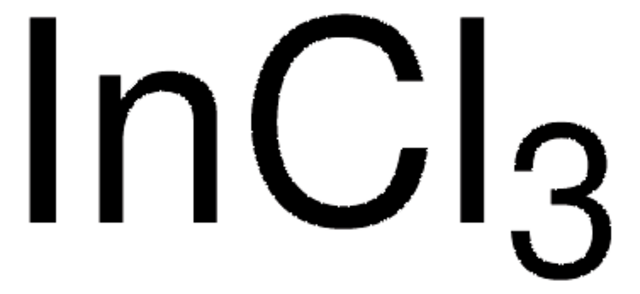651745
Copper(I) chloride
AnhydroBeads™, ≥99.99% trace metals basis
Sinônimo(s):
Copper monochloride, Cuprous chloride
About This Item
Produtos recomendados
grau
for synthesis
synthesis grade
Nível de qualidade
pressão de vapor
1.3 mmHg ( 546 °C)
linha de produto
AnhydroBeads™
Ensaio
≥99.99% trace metals basis
adequação da reação
reagent type: catalyst
core: copper
Impurezas
≤100.0 ppm Trace Metal Analysis
p.e.
1490 °C (lit.)
pf
430 °C (lit.)
solubilidade
slightly soluble 0.47 g/L at 20 °C
aplicação(ões)
battery manufacturing
cadeia de caracteres SMILES
Cl[Cu]
InChI
1S/ClH.Cu/h1H;/q;+1/p-1
chave InChI
OXBLHERUFWYNTN-UHFFFAOYSA-M
Procurando produtos similares? Visita Guia de comparação de produtos
Categorias relacionadas
Descrição geral
Aplicação
Informações legais
acessório
Palavra indicadora
Danger
Frases de perigo
Declarações de precaução
Classificações de perigo
Acute Tox. 4 Dermal - Acute Tox. 4 Oral - Aquatic Acute 1 - Aquatic Chronic 1 - Eye Dam. 1 - Skin Irrit. 2
Código de classe de armazenamento
8A - Combustible corrosive hazardous materials
Classe de risco de água (WGK)
WGK 3
Ponto de fulgor (°F)
Not applicable
Ponto de fulgor (°C)
Not applicable
Equipamento de proteção individual
dust mask type N95 (US), Eyeshields, Faceshields, Gloves
Escolha uma das versões mais recentes:
Já possui este produto?
Encontre a documentação dos produtos que você adquiriu recentemente na biblioteca de documentos.
Os clientes também visualizaram
Artigos
Nanostructured Materials Through Ultrasonic Spray Pyrolysis
Spectral conversion for solar cells is an emerging concept in the field of photovoltaics, and it has the potential to increase significantly the efficiency of solar cells. Lanthanide ions are ideal candidates for spectral conversion, due to their high luminescence efficiencies and rich energy level structure that allows for great flexibility in the upconversion and downconversion of photons in a wide spectral region (NIR-VIS-UV).
The prevailing strategies for heat and electric-power production that rely on fossil and fission fuels are having a negative impact on the environment and on our living conditions.
Nossa equipe de cientistas tem experiência em todas as áreas de pesquisa, incluindo Life Sciences, ciência de materiais, síntese química, cromatografia, química analítica e muitas outras.
Entre em contato com a assistência técnica









